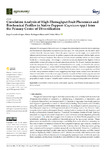Mostrar o rexistro simple do ítem
Correlation Analysis of High-Throughput Fruit Phenomics and Biochemical Profiles in Native Peppers (Capsicum spp.) from the Primary Center of Diversification
| dc.contributor.author | González-López, Jorge | |
| dc.contributor.author | Rodríguez Moar, Simón | |
| dc.contributor.author | Silvar, Cristina | |
| dc.date.accessioned | 2021-04-15T14:54:22Z | |
| dc.date.available | 2021-04-15T14:54:22Z | |
| dc.date.issued | 2021-01-30 | |
| dc.identifier.citation | González-López, J.; Rodríguez-Moar, S.; Silvar, C. Correlation Analysis of High-Throughput Fruit Phenomics and Biochemical Profiles in Native Peppers (Capsicum spp.) from the Primary Center of Diversification. Agronomy 2021, 11, 262. https://doi.org/10.3390/agronomy11020262 | es_ES |
| dc.identifier.issn | 2073-4395 | |
| dc.identifier.uri | http://hdl.handle.net/2183/27759 | |
| dc.description.abstract | [Abstract] The main goal of this work was to investigate the relationship between the fruit morphology and biochemical composition of peppers (Capsicum spp.). For that purpose, one hundred native varieties from the Andean region, where the genus Capsicum has its origin, were analysed for different phytochemical compounds. In addition, pepper fruits were assessed with the highly precise phenomics tool Tomato Analyzer. The collection showed a broad variability which was more evident within the C. annuum group. On average, C. frutescens accessions displayed the highest levels of solid soluble content, pH, polyphenols and antioxidant activity. The Tomato Analyzer descriptors under the categories of size, shape index, and latitudinal section, mostly contributed to the variance among Capsicum groups. C. annuum hold the larger fruits, whereas C. frutescens comprised fruits of smaller sizes. The correlation analysis revealed that biochemical traits were negatively correlated with the fruit parameters related to size, suggesting that huger fruits contain lower amounts of chemical metabolites. The multivariate approximations demonstrated that Andean peppers assorted according to morphometric and colorimetric characteristics, but independently of their species or geographical origin. Groups of valuable native varieties carrying promising traits were identified. | es_ES |
| dc.description.sponsorship | This research was funded by Spanish Institute for Agricultural and Food Research and Technology (INIA), co–financed by the European Regional Development Fund (FEDER) (Project RTA2015-00042-C02-02), and by Xunta de Galicia (Project ED431C 2018/57) | es_ES |
| dc.description.sponsorship | Xunta de Galicia; ED431C 2018/57 | es_ES |
| dc.description.sponsorship | This research was funded by Spanish Institute for Agricultural and Food Research and Technology (INIA), co–financed by the European Regional Development Fund (FEDER) (Project RTA2015-00042-C02-02), and by Xunta de Galicia (Project ED431C 2018/57) | |
| dc.language.iso | eng | es_ES |
| dc.publisher | MDPI | es_ES |
| dc.relation | info:eu-repo/grantAgreement/MINECO/Plan Estatal de Investigación Científica y Técnica y de Innovación 2013-2016/RTA2015-00042-C02-02/ES/APLICACIÓN DE HERRAMIENTAS GENÓMICAS Y METABOLÓMICAS PARA EL ESTUDIO DEL CARÁCTER PUNGENTE EN PIMIENTO Y CEBOLLA/ | |
| dc.relation.uri | https://doi.org/10.3390/agronomy11020262 | es_ES |
| dc.rights | Atribución 4.0 Internacional | es_ES |
| dc.rights.uri | http://creativecommons.org/licenses/by/4.0/ | * |
| dc.subject | Solid soluble content | es_ES |
| dc.subject | Acidity | es_ES |
| dc.subject | Antioxidant capacity | es_ES |
| dc.subject | Polyphenols | es_ES |
| dc.subject | Tomato analyzer | es_ES |
| dc.subject | Correlation analysis | es_ES |
| dc.title | Correlation Analysis of High-Throughput Fruit Phenomics and Biochemical Profiles in Native Peppers (Capsicum spp.) from the Primary Center of Diversification | es_ES |
| dc.type | info:eu-repo/semantics/article | es_ES |
| dc.rights.access | info:eu-repo/semantics/openAccess | es_ES |
| UDC.journalTitle | Agronomy | es_ES |
| UDC.volume | 11 | es_ES |
| UDC.issue | 2 | es_ES |
| UDC.startPage | 262 | es_ES |
| dc.identifier.doi | 10.3390/agronomy11020262 |
Ficheiros no ítem
Este ítem aparece na(s) seguinte(s) colección(s)
-
GI-GIBE - Artigos [74]






